American
Whiskey:
WEST VIRGINIA
DISTILLING COMPANY
Mountain Moonshine
Spirit Whiskey
Mountain Moonshine Old Oak Recipe
June, 2005
MORGANTOWN, WEST VIRGINIA attorney Payton Fireman is
a man in constant motion. During our visit with him, Linda notes that he
never once stops moving, sometimes going in and out of the same storage
room two or three times. A fascinating and refreshing young man, Payton
came to be a legal moonshine distiller because the golf accessories
business he began wasn't doing as well as he'd hoped it would, and he
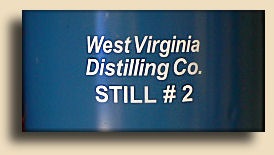 was
becoming bored. His friend, Bo McDaniel, had an old bootleg corn whiskey
recipe and a transmission repair shop with an available bay, and the two
of them formed the West Virginia Distillery Company and proceeded to
obtain the needed licensing. They began distilling Mountain Moonshine in
1997.
was
becoming bored. His friend, Bo McDaniel, had an old bootleg corn whiskey
recipe and a transmission repair shop with an available bay, and the two
of them formed the West Virginia Distillery Company and proceeded to
obtain the needed licensing. They began distilling Mountain Moonshine in
1997.
We don't ask Payton what sort of training or experience they may have had before deciding to become distillers, and he doesn't elaborate on that issue. He does, however, note that the partnership didn't continue for long and he has been the sole operator for all but the very earliest part of the enterprise, despite the fact that all the publicity continues to tie the two together.
We meet Payton in front of his law office in Morgantown and we follow him as he leads us down a twisty, winding road that runs along the side of the river. Which, by the way, is the very same Monongahela River associated with the commercial rye whiskey industry that once thrived downstream from here in western Pennsylvania. After a mile or two we come to Granville, an area of small houses and light industrial shops, one of which is identified by a small sign on the door as McDaniel's Automotive.
No collection of brick buildings or galvanized steel-clad warehouses here. Uh-uh. And no four-story tower to accommodate a continuous column still, either. Payton unlocks the door and we enter. Well, it doesn't look like a garage anymore, but it sure looks a lot different than any other distillery we've seen. A little like a small food-processing plant which, if you think about it, it pretty much is. One could easily imagine MRS. Moonshiner canning peas here, or making pies.
To give you an idea of what sort of guy Payton
Fireman is, understand that his first inkling that there were people
who were interested in visiting and touring his facility was when we
called his home phone this morning to tell him we were parked outside his office.
He simply stopped whatever he was doing and drove from his home to the office,
then on to wrap up some business he needed to do, then back to where we
were, all in the space of less than half an hour.
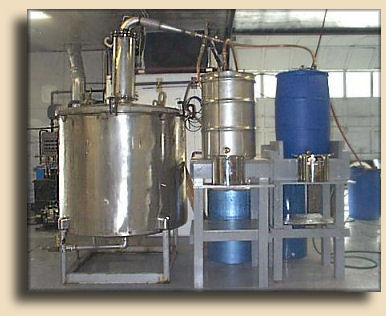 He
then led us here to the garage/distillery and is now showing us everything there is
know about how the West Virginia Distilling Company distills.
He
then led us here to the garage/distillery and is now showing us everything there is
know about how the West Virginia Distilling Company distills.
Despite the automotive ambiance, you'll not be finding any
rusty Chevrolets here. And the whiskey that comes off the pot still isn't
run through old truck radiators, as is too often the case with "real"
moonshine. Fireman takes his whiskey-making as seriously as any good craft
brewer takes his beer. The floor is clean. The stainless steel pot still
gleams. So does the steel pump that Payton bought and used as a
template for the all-brass one he engineered and built.
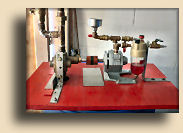 Why
brass? Because brass doesn't create sparks. And sparks are something you
really don't want in a building full of whiskey fumes.
Why
brass? Because brass doesn't create sparks. And sparks are something you
really don't want in a building full of whiskey fumes.
Yes, it's that level of detail that he brings to this half-business/half hobby.
And does Payton Fireman do these things in order to produce
the finest corn whiskey ever made?
Of course he does.
Or maybe not.
Whatever.
Did Andy Warhol try to produce a Mona Lisa masterpiece?
For that matter, did DaVinci?
Mountain Moonshine is simply a corn whiskey product that is popular enough to be profitable, despite the taxes. It isn't marketed toward the same people who prefer Wild Turkey to Maker's Mark. It's positioned as an acceptable-quality product with a broad appeal among consumers of both flavored-vodka-like spirits and novelty whiskey. And it's made by an individual craftsman in his own shop.
Payton knows who his market is, and his goal is to produce a spirit with a smooth, delicate flavor which hints of real corn moonshine whiskey without clubbing the poor drinker over the head with it. Perhaps his customers enjoy serving their friends West Virginia Sunrises instead of those made with ordinary tequila.
Or 'Bama Mammies made with Mountain Moonshine instead
of ho-hum, everyday Bahama Mamas with Bacardi Silver .
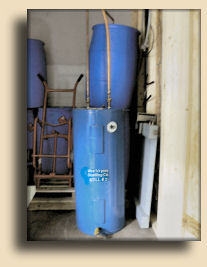
Or how about a
James (bottled in) Bond? That would, of course, be made with Mountain
Moonshine, over which one quietly whispers t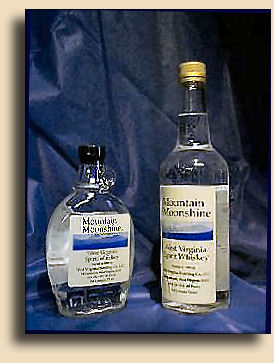 he word "vermouth", and is
neither stirred nor shaken, but just "whupped up" a bit.
he word "vermouth", and is
neither stirred nor shaken, but just "whupped up" a bit.
To make a spirit suitable for such irreverancies, Payton's Mountain Moonshine product is "assembled" from mostly flavorless grain neutral spirits (vodka), and the corn whiskey he actually ferments and distills here. While Chuck Miller makes pure corn whiskey in much the same way that the 18th century farmers did, Payton makes what is essentially bourbon white dog, using mostly corn, but with around 10% rye grain for additional flavor and 10% malted barley to develop the enzymes that will convert the cornstarch into sugar for fermenting. Malting is the process of dampening the grain kernels as if to prepare them for planting. That causes them to convert their own starch into sugar and begin to sprout. The germination process is then halted by heating the newly-sprouted grain, leaving the kernels full of the starch-converting enzyme, which can then be used for converting larger batches of grain starch to fermentable sugars. The enzymes in barley are much more effective than those that occur naturally in corn or rye, even when used with those grains, and therefore barley has become the grain of choice for all types of whiskey, including corn. Of course, unless they grew it themselves, barley wasn't an available option for the 18th century corn or rye farmers; they had to malt whatever they were using to make their whiskey. In the same way, Chuck Miller, whose desire is to emulate the old style as much as possible, malts his own corn. Mountain Moonshine uses malted barley. John asks Payton if he was aware when he started making whiskey that his corn-rye-barley malt recipe is more typical of bourbon whiskey than of real moonshine, which also uses a fair amount of cane sugar.
"Yes, I've always known that," the distiller answers, "And
that's just not the kind of product I want to make. The 'shine you're likely to
get from an illegal moonshiner is almost ALL sugar-likker.
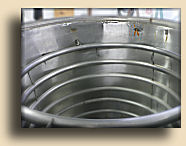 There's no corn
or grain of any kind in it, not even for flavor. That's not the kind of
spirit I want to make".
There's no corn
or grain of any kind in it, not even for flavor. That's not the kind of
spirit I want to make".
A distilling "run"
consists of three distinct sections or "cuts". When the process first
begins to produce liquid at the end of the long, spiraling tube called a "worm", it contains mostly those
components that vaporize at the lowest temperatures. These would include
methanol, acetone, keytones, and various esters and aldehydes. This part
of the run is called the "foreshots" or "heads", and is considered unfit
or even dangerous
to use. Small quantities simply taste terrible; larger amounts can blind
or kill. Toward the end of the run, as the still's temperature rises into
the range where less volatile elements vaporize, the distillate begins to
take on other flavor components. These "fusel oils", which ones are
present and in what quantity, are critical to how one distiller's output
will differ from another's. Or even his own from batch to batch. The
distiller's trick is to choose exactly the right time to stop collecting
distillate. At that point, any further output,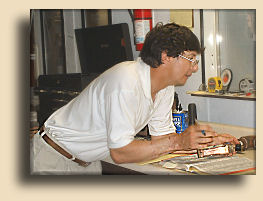 now called "tails" or
"feints", are
redirected to a storage tank for later re-use. The whiskey that is produced
between these two events is called the "heart" or "middle cut" and is
what's kept.
now called "tails" or
"feints", are
redirected to a storage tank for later re-use. The whiskey that is produced
between these two events is called the "heart" or "middle cut" and is
what's kept.
Payton uses a very narrow cut in his distillate, discarding or reusing all
but the middle 15% of what his small still produces. He says this
"middle cut of the middle cut" is the way he wants all of his whiskey to
taste. Old-time pot-still moonshiners would certainly understand that;
they often reserved that portion for their own family's use. Many modern
moonshiners go even one step further, reserving all of their corn whiskey
for personal consumption and making "sugar likker" for general sale.
Sugar, just regular 50 lb. bags of Dixie Crystal, ferments cleaner and much
faster than malted grain. It doesn't taste very good, but it will produce
alcohol, either by simply letting it ferment (bathtub gin) or distilling
the alcohol from it (white lightning). Most moonshine sold is sugar likker;
only personal friends of the distiller are likely to taste his real corn
or rye whiskey. Payton doesn't make sugar likker. And he even goes a step
beyond most quality moonshiners, who use mainly all corn with just a
little sugar to help things along: Mountain Moonshine is made using no
sugar at all, and a mash of corn, rye, and malted barley that is identical
to the ingredients in bourbon whiskey. The result is a very flavorful "white dog" that
could be used for making bourbon if he were so inclined.
But, for now at least, he isn't. In fact, when John asks him what he'd do
differently if he were to start all over, Fireman answers quickly, "I'd do
something completely different, that's what. I'd rather be an internet
services provider. Or something. I wouldn't be doing this". We think he's
kidding, although he says it perfectly deadpan and he doesn't retract it. But then he starts talking about distilling and quality, and the passion
begins to leak through. Payton has a different take on the business part
of distilling than most of the other distillers we've met. He knows he's
making a niche product, and he has a pretty down-to-earth idea of who his
customers are. In that respect, he is probably closer in spirit (pun
intended) to the farmer-distiller of the 18th century than to the master
distillers of today. You'll find no international gold medals displayed on
Mountain Moonshine labels. But you will see people buying and drinking it.
Lots of people. And at thirteen dollars a bottle, it's not because they can't find
cheaper alcohol. Of course, some buy it because it has that aura of
"forbidden fruit" (well, forbidden grain anyway), with all it's romantic
overtones. And some buy it because they like the flavor. Fireman aims his
whiskey at both segments. Obviously, calling his product Mountain
Moonshine appeals to the first group. It's no accident that Rodney Facemire's corn liquor is called "Southern Moon", and Chuck Miller's corn
whiskey is called "Virginia Lightning" (or Tennessee Lightning, or Carolina
Lightning, depending on what state it's bottled for). But Payton is aware
of another important marketing fact: most people don't really like the taste of
whiskey. Especially raw corn whiskey. And in its pure state it's simply too strong for mixing. Payton makes strong, full-flavored corn whiskey; but he mixes only
about 20% of that whiskey with 80% flavorless grain neutral spirits to
bring it down to a level that more people will accept. In doing so, he
loses his ability to legally call his product "whiskey". Mountain
Moonshine is labeled as "spirit whiskey", a legal designation that places
it behind even blended whiskey in the spirit pecking order. But that's
okay with him. If that's what it takes, so be it. The result is a light and
delicate raw corn whiskey which has no equal in that quality. Corn whiskey
purists will probably hate it. But the sort of people that Jack Daniel's spent
millions to develop Gentleman Jack for will love it. So would those who
keep Basil Hayden profitable despite its near-universal ridicule by the "I
don't drink sissy whiskey" set.
And like Miller's Copper Fox, Payton also makes a "wood-aged" version of
Mountain Moon. The method he uses, which is to soak toasted oak chips in the
whiskey for several weeks until the flavors have been infused into the
spirit, is forbidden to brands that want to call themselves "straight" whiskey.
That designation can only be given to whiskey whose color and flavor have
come from years of aging in new, charred, oak barrels. And no real moonshiner would be caught dead with 'shine aging in oak barrels. But
hobbyists, both wine and spirit makers, have long used toasted wood chip
infusion to enhance the flavor of their products. And so does Payton
Fireman with his "Old Oak Recipe" bottling.
![]()
 |
|
Story and original photography copyright © 2005 by Linda Lipman and John Lipman. All rights reserved. |


